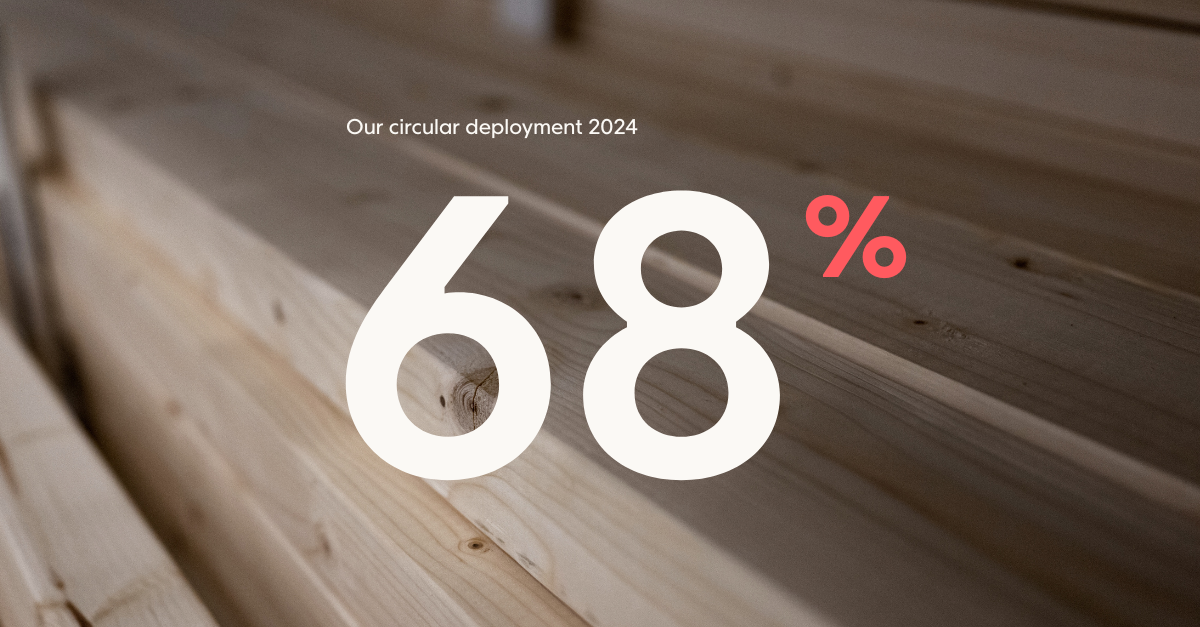News Sustainability Circularity Index
Adapteo and Arup launch Circularity Index for modular construction
- 2 min reading

The Circularity Index measures real-world circularity performance, setting a new standard for transparency and accountability in the built environment, closing a critical industry gap. 
Adapteo and Arup announce the launch of Adapteo’s Circularity Index, a framework for measuring and reporting circular performance in modular construction. The pioneering, sector-specific Index tracks circular deployment, material circularity, and design circularity to give a comprehensive picture of how resources are used, reused, and recovered across Adapteo’s fleet of flexible, moveable buildings.
There is currently no standardised method to assess how circular a modular building or asset portfolio is. This new framework provides transparent, data-backed insights into the circular economy in action, from the proportion of reused modules in projects to the share of renewable and recycled materials in new builds.
The Index measures performance across three core dimensions: circular deployment, material circularity, and design circularity, giving Adapteo, a practical roadmap for reducing virgin material use, increasing reuse, and extending asset lifecycles. When applied to Adapteo’s 2024 operations, the Index revealed a 68% circular deployment rate, meaning that the majority of demand was met through reused modules or circular material sources rather than new, virgin inputs. While we are still refining thresholds and definitions, the Index ensures that growth and circularity are tracked together, so expansion drives long-term improvement.
For comparison, today’s global economy is estimated to be only 6.9% circular (Circularity Gap Report 2024), showing why measuring progress matters.
Primary results of the Index highlight seven strategic opportunities to accelerate progress, including enhancing design for disassembly, expanding digital tracking, optimising storage, and increasing use of bio-based and secondary materials. Acting on these insights will be critical while Adapteo grows, ensuring that expansion strengthens rather than dilutes long-term sustainability performance.
Moreover, it aligns conceptually with European Sustainability Reporting Standards (ESRS E5) and the EU Taxonomy, ensuring it can serve as both a strategic business tool and a compliance-ready reporting framework. Building on existing circular analysis and reporting efforts - such as the World Business Council for Sustainable Development’s (WBCSD) Circular Transition Indicators (CTI) - the Index applies, for the first time, a comprehensive approach to modular buildings.
Dr. Lina Wiles, Chief Sustainability Officer, says: “Our Space-as-a-Service model is built on circular principles, but until now we had no way to measure our impact. Developed with Arup through a truly collaborative process, this tool not only tells us where we stand today, it charts the course for where we want to go, guiding our journey to increase Adapteo’s circularity and, hopefully, inspiring our whole sector to raise the bar for circular performance in the built environment.”
Sean Lockie, Climate Leader at Arup, says: “It’s great to have forward thinking clients like Adapteo who are open and committed to sharing their work to help advance the industry. The Circularity Index offers a framework which will bring clarity and consistency to how we measure circularity in the built environment. By combining key data with a practical guidance, the tool will empower organisations to make informed decisions to reduce environmental impact and align with sustainability regulations. We look forward to seeing how it drives progress in the sector.”
The Circularity Index is intended to evolve with feedback and application across the sector, providing a living reference model for the built environment. It is based on open methodology and reproducible logic so that other industry actors can apply, test, and refine it in different markets and contexts.
These results show not only where Adapteo stands today, but where the greatest opportunities lie to increase circularity over time. They also underline a simple fact that as we grow, circularity is how we keep building in a world with limited resources by reusing more, wasting less, and making every unit last longer.